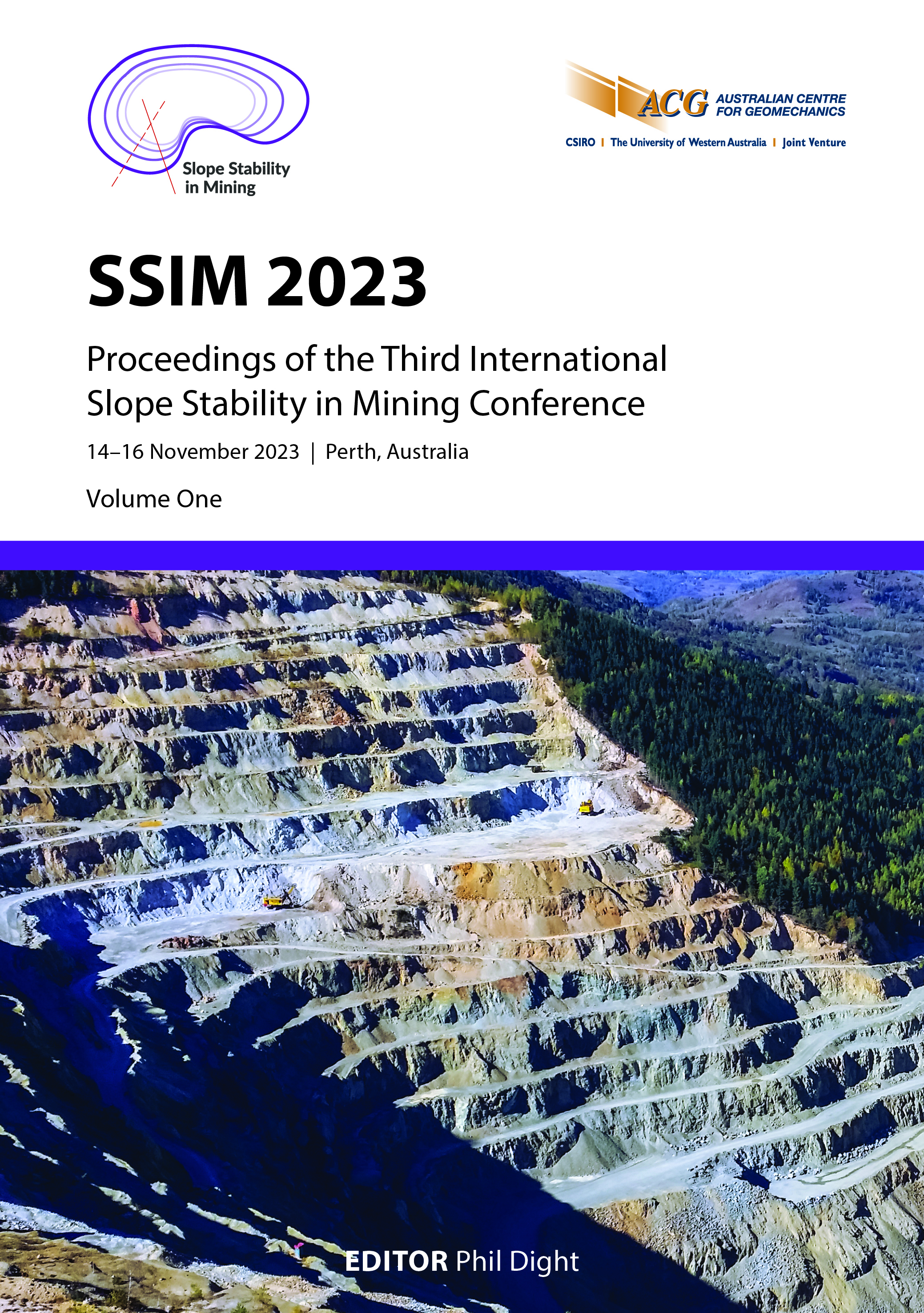Preventing pit wall failure through early detection monitoring, geotechnical analysis and execution of a toe-stabilisation buttress

|
Authors: Jonsson, V; Nairn, L |
DOI https://doi.org/10.36487/ACG_repo/2335_58
Cite As:
Jonsson, V & Nairn, L 2023, 'Preventing pit wall failure through early detection monitoring, geotechnical analysis and execution of a toe-stabilisation buttress', in PM Dight (ed.), SSIM 2023: Third International Slope Stability in Mining Conference, Australian Centre for Geomechanics, Perth, pp. 831-852, https://doi.org/10.36487/ACG_repo/2335_58
Abstract:
Multi-batter scale instabilities in open pit mining create significant fall of ground hazards with potential for large runout distances of failed material. When such instabilities are identified, one possible geotechnical management approach is to use live radar monitoring of the slope to allow work to continue in the area until progressive deformation exceeds predetermined safe thresholds, at which point workers are withdrawn from the area until ‘controlled’ failure occurs. However, when the predicted failure and runout zones include a haul ramp or other critical infrastructure, failure prevention is often more economically favourable than accepting a ‘controlled’ failure. A common remediation approach for rotational slope instabilities is to add a resisting force to the toe of the slope, usually in the form of a buttress. The construction and scale of the buttress is determined by geotechnical modelling. This paper presents a case study of a toe-stabilisation buttress used to support an identified slope instability comprised of variable strength detrital materials at a Western Australia Iron Ore open pit mine. This case study covers the early detection of slope movement, subsequent geotechnical finite element analysis of the slope, buttress design and the execution strategy used to ensure a psychologically safe environment for operational personnel. The integrated solution is discussed, including the four-dimensional slope environment during progressive, transitional and regressive movement stages, as well as considerations for surface water management. Satellite InSAR, ground-based prism systems and ground-based radar systems were used, with real-time deformation alarming, 24/7 monitoring and a trigger action response plan in place. The geotechnical remediation has allowed continued productive movement in the pit. Batters underneath the buttress are currently being blasted and excavated under an approved geotechnical design, without reactivation of slope movement above alarm thresholds.
Keywords: slope monitoring, radar monitoring, operational safety, buttress
References:
Aldas, G 2010, ‘Explosive charge mass and peak particle velocity (PPV)-frequency relation in mining blast’, Journal of Geophysics and Engineering, vol. 7, no. 3, pp. 223–231,
Bureau of Meterology 2023, Coondewanna, Western Australia, February 2023 Daily Weather Observations, Australian Government Bureau of Meteorology, Melbourne, viewed 4 July 2023,
IDCJDW6151.202302.shtml
de Bruyn, IA 2021, ‘Building useful geotechnical models’, in PM Dight (ed.), SSIM 2021: Second International Slope Stability in Mining, Australian Centre for Geomechanics, Perth, pp. 37–50,
Diederichs, MS 2007, ‘Mechanistic interpretation and practical application of damage and spalling prediction criteria for deep tunnelling’, Canadian Geotechnical Journal, vol.44,
Dixon, R, Tovey, L & Shilov, E 2022, ‘Slope radar monitoring - a partnership and infrastructure case study of scalability, reliability and availability’, paper presented at AusRock Conference, Melbourne.
Foot, B & Armitage, S 2022, ‘Setting the foundation for a speak up culture: psychological safety in action’, paper presented at Queensland Mining Industry Health & Safety Conference, Gold Coast.
Geoscience Australia 2023, Interferometric Synthetic Aperture Radar, Australian Government, Canberra, viewed 4 July 2023,
Harries, N & Jacobsen, C 2022, ‘The risk management and cost benefits of using a total monitoring approach to managing slope instability hazards in open pit mines’, paper presented at AusRock Conference, Melbourne.
Klein, C & Gole, MJ 1981, ‘Mineralogy and petrology of parts of the Marra Mamba Iron Formation, Hamersley Basin, Western Australia’, American Mineralogist, vol.66, pp. 507–525,
/files/17258.pdf
database/mineinfo.asp?mineid=mn340
Rocscience 2023a, Slide2, computer software, Rocscience, Toronto, https://www.rocscience.com/software/slide2
Rocscience 2023b, RS2, computer software, Rocscience, Toronto, https://www.rocscience.com/software/rs2
Young, K, Martin, M & Payne, D 2022, ‘A case study in managing a high consequence geotechnical risk in a Queensland coalmine’, paper presented at AusRock Conference, Melbourne.
© Copyright 2026, Australian Centre for Geomechanics (ACG), The University of Western Australia. All rights reserved.
View copyright/legal information
Please direct any queries or error reports to repository-acg@uwa.edu.au
View copyright/legal information
Please direct any queries or error reports to repository-acg@uwa.edu.au

